|
Some time ago I was asked (by the
Bishop
Berkley) if I thought Paul Morphy might have witnessed the Mardi Gras. At
the time, I had no idea but it seemed likely that he would have. From this
passage in Regina Morphy-Voitier's pamphlet, it would seem that it was more than
just "likely."
On the left hand side of the house still facing
Royal street, was Mrs. Morphy's bed room, which since her husband's death, she
shared with her daughter, Helena. This room opened on a very small balcony from
which the writer (then a small child) remembers viewing the passing of the
carnival parades, for at that time, the pageants traversed the principal streets
of the Vieux Carré. [pages 37-38]
We also know the Morphy attended the opera at the French Opera
House
Paul Morphy was exceedingly fond of grand opera
and very seldom missed a performance at the old French Opera House on Bourbon Street, which
was unfortunately destroyed by fire in 1920. [page 28]
and enjoyed the musical evenings provided by his mother and in
his own home
The Morphy home at number 89, Royal Street was,
at all times, the centre of gayety and pleasure. Almost every week, Mrs.
Morphy entertained large house parties, and her weekly "musicales" were highly
artistic and enjoyable. Although Paul was not a musician in the true sense of
the word, he was noted for his splendid ear for music, and once he heard a
tune, he never forgot it, and he thoroughly enjoyed these evenings devoted to
classic music and brilliant conversation. [page 28]
as well as some musical entertainment provided by family members
But if the weather was inclement, the family
would enter the music room where his sister-in-law would sing one of his favourite
songs or play one of the classics, and Morphy was soon lost in a day dream.
[page 30] (Morphy's sister-in-law was Alice Percy, 1839-1896)
In this posting, I wanted to look at more general things,
particularly three celebrities who shared some of the public's interest
with Morphy during the height of his fame. One of these was Morphy's
fellow New Orleanian Adah Isaacs Menken
whom I already presented in another posting. The other two as Charles
Blondin and John Heenan, whose lives interwove with that of Menken.
Charles Blondin
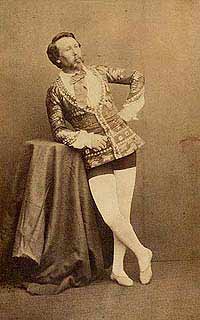
Jean François Gravelet was born on February 28, 1824 in St. Omar, France. His
father was a gymnast and sent Jean to the École de Gymnase at Lyons when he was
just 5 years old and within 6 months, he was entertaining crowds as an
acrobat, performing as the Little Wonder. When Jean turned 9, his father
died leaving him on his own. Jean supported himself by performing
professionally. While performing with the Ravel Troupe in 1851, Jean changed his
name to Blondin, referring to the color of his hair, and it was during their
tour of the U. S. in 1858
- as part of Barnum’s Greatest Show on Earth - that Blondin first
saw the Niagara Falls and conceived the stunt that would secure his fame. People
back then weren't so keen of the commercialization of landmarks and Blondin had
a very tough time getting the necessary permissions to allow him to perform his
feat - crossing over the Falls on a tightrope. Eventually he had to settle with
crossing a mile downstream from the falls on a 3" hemp rope, 1100' long and at
an angle made by a height of 240' on one end and 160' on the other. A crowd of
100,000 people watched Blondin cross the Falls for the first time on June 30th
1859. He completed his crossing in 20 minutes using a thirty long balancing pole
that weighed 40 pounds.
His act wasn't a one-time performance but rather a series
of 9 engagements during which he devised evermore creative and difficult
variations such as balancing a chair on the tightrope and standing on it,
photographing the crowd below, walking on stilts, pushing a wheelbarrow,
transversing blindfolded, cooking a meal on a portable grill and lowering
it to the surprised passengers on the Maid of the Mist below.
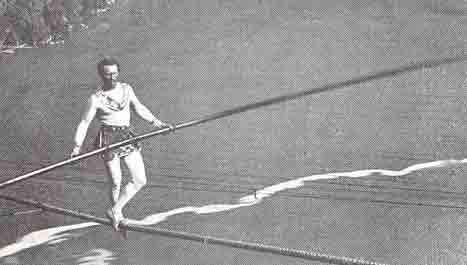
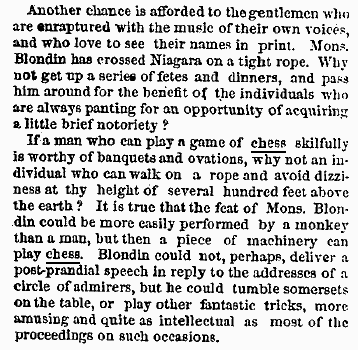
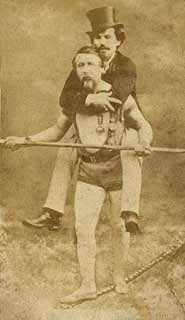
On August 17, 1859, Blondin carried his manager, Harry Colcord, across the Falls
on his back.
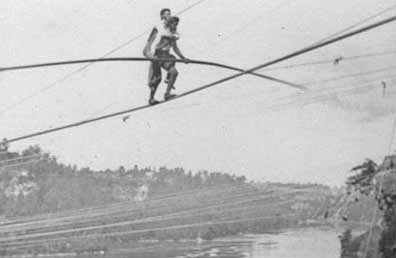
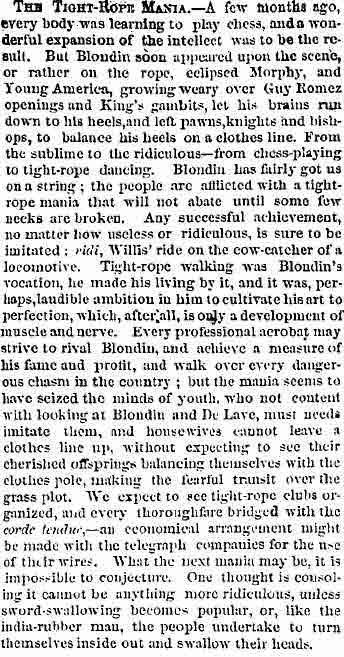 Blondin
met and married his wife Charlotte in 1853 during a tour of New York. By the
time of his Niagara performance, he had 3 children: Adele, born in New York;
Edward, born in Louisiana; Isis, born in Ohio. He bought a home in the city of
Niagara which housed his family, his manager and 2 servants.
It's said, but unconfirmed, that during his Niagara
performance, Blondin met Adah Issacs Menken and was smitten by her and
wanted to marry her. But Menken wanted to learn to dance on the tightrope
so they could perform together and Blondin refused the request as being
too dangerous. They toured together for a while in the vaudeville circuit
and then parted ways. Like Morphy, Blondin was feted and
honored, and even had a song, the Blondin March, named after him. In 1862
he performed at the Crystal Palace before the Prince of Wales (who declined
Blondin's offer to carry him across the Falls on the tightrope when he first
witnessed Blondin's performance in 1861) in a re-creation of his Niagara
performances that involved a tightrope stretched across the Centre Transept 180
feet above a concrete floor. His five year old daughter, Adele, sat in a
wheelbarrow, scattering rose petals on the crowd below. He
performed throughout the world, giving his final performance in 1892 in Belfast,
Ireland. He was earning $500 per performance by then and reputedly earned
$400,000 during his last two years.
Blondin died of diabetes
in Ealing on February 22, 1897 a few days shy of 73 years old and was
buried in Kensal Green Cemetery in London next to his first wife,
Charlotte, who had died in 1888. His second wife, Katherine, when she died
in 1901, would be buried on his other side.
|
John Heenan |
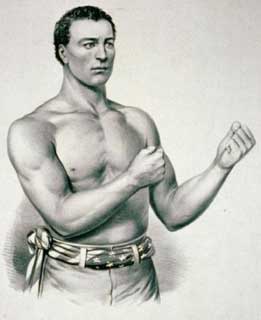 |
John Camel Heenan was born in Troy, N.Y. on May 2,
1835. He family were Irish immigrants. Hoping to get rich, he moved to
California when he was 17. Having just missed the gold rush, he ended up
working for the Pacific Mail and Steamship Company in the city of Benicia,
a job that required him to swing a 20 lb. sledgehammer all day long. His 6
foot 2 inch frame was one of solid muscle weighing him in between 185-192
lbs. He took up bare fist boxing under the name, "Benicia Boy"
Heenan's rise to fame began when he fought John Morrissey for the
American Heavyweight title in 1858.
Morrissey, born in Ireland in1831, was named "Old Smoke"
after having been pinned on top of burning coals from an upended coal
stove during his bout with an Indian named Tom McCann. Morrissey fought on
paying no heed to his burning flesh. Unimpressive in style and skill,
Morrissey made up for his faults with determination and fierceness. He
became the heavyweight champion in 1853 when, after being plummeted
mercilessly by his opponent, Yankee Sullivan, he won on a technicality
when Sullivan left the ring and ignored the "time" call.
Morrissey died in 1878 at age 47.
|
|
Morrissey successfully defended his title against Heenan
in a vicious 11 round fight on October 20, 1858 at Long Point, Canada.
An exciting and descriptive newspaper account of the fight can be read
here
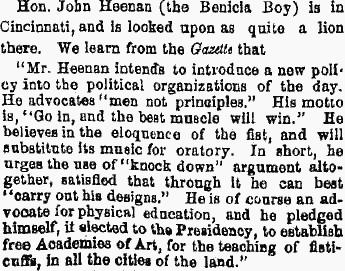
From this December 1858 news blurb we learn that right
after his lost bid for the American Heavyweight title, Heenan was
extremely popular.
When Morrissey refused a rematch in 1860 and retired,
Heenan claimed the title and was awarded the Silver Belt
Heenan looked towards England and winning a Word
Heavyweight Title.
May 5, 1860

In the meantime Heenan became even more famous because of his 1859
marriage to Adah Isaacs Menken . The
marriage didn't last long and Heenan, in fact, denied it ever took place,
but the divorce was granted in 1861. They had a boy child together
but it died in infancy. Rumor had it that Heenan used Adah as a personal
punching bag, beating her up every evening after supper.
Heenan actually was the first boxer to use weight lifting
and punching bags as part of his training regimen.
September 10, 1861
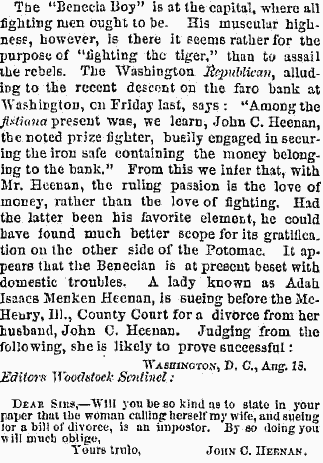
|
|
Thomas Sayers, the Brighton Boy, was the
English Champion. In his career he was only beaten one time, in 1853, by
the improbable fighter,
Nat Langham.
Born in May of 1826, Sayers was a bricklayer by trade. Not only was he
powerfully built, but he was known for his speed and dexterity.
He greatest weakness, at least against Heenan, was his height and reach.
He stood 5'8" and weighed 154 lbs. He claimed the Heavyweight Championship
of England in 1857 when he beat William Perry and he defended it
convincingly 4 times before meeting with Heenan. After fighting Heenan,
Sayers retired from boxing. He was awarded £3000, all of it raised
by public subscription, for his retirement at age 35. His investments let
him live a leisurely life that unfortunately ended in November 1865 when
he died of tuberculosis at age 39.
His final bout with Heenan was as brutal as any fight
could be. It was touted as the First World Heavyweight Title Fight and it
was the last on in England under the old rules. In 1866, boxing adapted
the Marquis of Queensberry Rules stating:
Fighters will wear gloves
No wrestling
Three minute rounds
One minute rest period
Ten seconds to recover from a knockdown
Heenan fought Sayers on April 17, 1860 in Hampshire,
England. Before the fight, Heenan wrote these lyrics:
I’ll wind our colors ‘round my loins
The blue and crimson bars -
And if Tom does not feel the stripes,
I’ll make him see the stars!
As early as the 6th round, Heenan fractured Sayers' right
arm with a powerful blow. After 36 rounds and two hours of fighting, the
constables tried to beak up the fight since Sayers couldn't move his right
arm and Heenan was virtually blind from the blood in his eyes, but the
fighters continued until the 42nd round when the spectators
were urged to rush the ring and stop the fight.
The fight was declared a draw and both contestants were awarded a
Championship Belt.
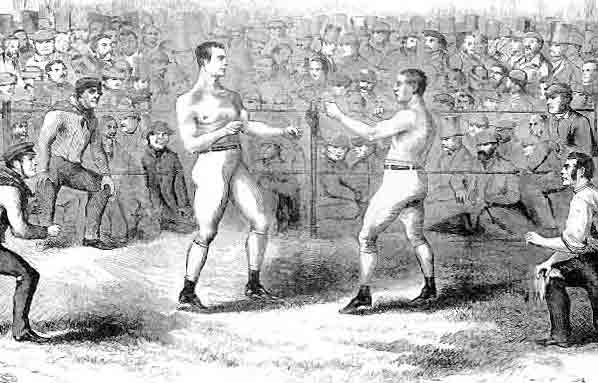
Thomas Nast, sent to England by Frank Leslie's
Illustrated Newspaper to cover the championship boxing
match between John Camel Heenan and Thomas Sayers, sketched this scene
(Heenan on left; Sayers on right)
The fight has been commemorared in song and verse: |
Heenan and Sayers
It was in the merry England, that home of Johnny Bull.
Great Britain filled her glasses, and filled them brimming full,
Says, "There's a toast to Drake, likewise to Britons brave,
For the champions we are on the land and the wave.
Then up rose Uncle Sam, and he looked far o'er the main,
"Is that the British Bull that's a-bellow'ing again?
Has he so soon forgotten the giant on the plain
That was always playing lightning when his day's work was done!"
"Or does he yet remember the Bunker Hill of old,
Or once upon Lake Erie with Perry brave and bold,
Or the bold charge at Yorktown when we caused him for to sigh?
Beware of Yankee muscle, Johnny Bull, mind your eyes!"
It was in the merry England, all in the bloom of spring,
When Britain's noble champion stood stripped all in tbe ring
To meet our noble Heenan, the galliant son of Troy
To try his British muscle on our bold Benicia boy,
There was two heavy flags that floated o'er the ring-
And the Briton's was the lion, just ready for to spring,
Ana tne Yankee's was the eagle, and a noble bird she was,
For she carried a bunch of thunderbolts in each of 'er claws.
Now the coppers they were tendered as the milling match began.
To the one on bold Sayers the bets came rolling in,
They fought like noble heroes, till one received a blow,
And the red crimson tide from our Yankee's nose did flow.
"First blood!" cried Johnny, "Let England shout for joy!"
They cheered their British bully whilst our bold Benicia boy
Says, "Let the tiger entertain them," and lightning flashed his eyes,
Saying, "Smile away old England, but Johnny mind your eyes."
The grand round of all, boys, this world has never beat
He grabbed their English boy, and he hurled him from his feet,
His followers they cheered him as he held him in the air
And from his grasp he flung him, which made the Britons stare.
Now come all ye jolly young men who'd friends and fortune make
Come look upon the eagle, ana never be afraid
May our Union stand forever, and our flag will be unfurled,
And the Star Spangled Banner will float 'round the world.
|
Heenan and SayersCome all you lovers of
the fisticuff
Attention to my song,
For I'll sing to you a verse or two
It won't detain you long.
It's to describe a champion fight,
Your time I now employ,
Which took place between Tom Sayers
And the bold Benicia Boy.
So! Hurrah my boys for Heenan
And Tom Sayers we will sing,
For they are the best and bravest
Ever fought in a British ring! |
Heenan fought his
last bout (outside of exhibition fights) on December 10, 1863 when he lost
to English Champion, Tom King. It was contested "in a field next to the
Sparrows Green Playing Fields [in Wadhurst]...It lasted for twenty four
rounds and was won by Tom King. On the day of the fight a special train
left London Bridge carrying the two contestants, officials, spectators and
punters. Neither Kent nor Sussex police had any warning of this fight and,
according to an entry in The Story of Wadhurst, it was also a
complete surprise
to the owner of the field. His tenant, on return from a holiday, was very
angry about the damage caused to the meadow and to the
breaking of his hedges and gates."Heenan traveled with Sayers giving
exhibitions and later (1869-70) he traveled with Englishman "Gypsy" Jem
Mace , the Father of Modern Boxing.
John Camel Heenan died at Green River Station, at the mouth of the
Grand Canyon, Wyoming Territory on November 2 1873, and was buried in St
Agnes Cemetery in Menands (North Troy), New York. |
|

